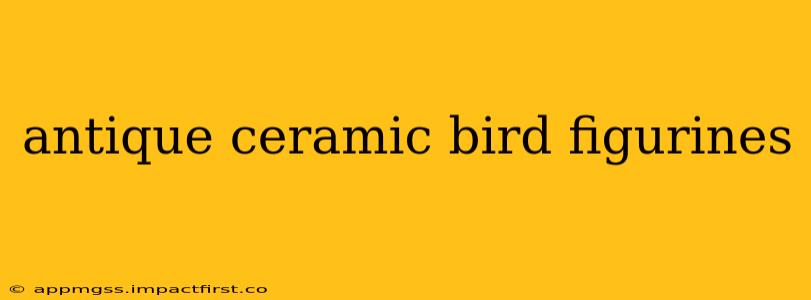Antique ceramic bird figurines are more than just decorative pieces; they are charming glimpses into the past, reflecting artistic styles and cultural trends across various eras. From delicate porcelain songbirds to whimsical earthenware poultry, these collectible treasures offer a fascinating blend of history, artistry, and aesthetic appeal. This guide will delve into the world of antique ceramic bird figurines, helping you identify, appreciate, and potentially even invest in these delightful artifacts.
What Makes an Antique Ceramic Bird Figurine Valuable?
Several factors contribute to the value of an antique ceramic bird figurine. The most important are:
-
Age and Origin: Older figurines, particularly those from renowned pottery studios or specific historical periods (e.g., Victorian era, Art Nouveau), command higher prices. Knowing the origin – the country or region where it was made – is crucial for accurate appraisal.
-
Maker's Mark: The presence of a maker's mark, often a signature, logo, or factory stamp, is a significant indicator of authenticity and can greatly increase value. Researching the maker can reveal information about their reputation and the figurine's production date.
-
Condition: The condition of the figurine is paramount. Chips, cracks, repairs, and significant discoloration can drastically reduce value. Minor wear consistent with age is acceptable, but major damage is a serious drawback.
-
Rarity: Figurines produced in limited quantities or those featuring unique designs or subject matter are highly sought after and command premium prices.
How to Identify Antique Ceramic Bird Figurines?
Identifying antique ceramic bird figurines requires a keen eye for detail and some research. Here's what to look for:
-
Materials: Examine the clay body. Porcelain is typically fine-grained and translucent, while earthenware is more porous and less refined. The glaze type (e.g., matte, glossy, crackled) can also indicate age and style.
-
Glazing Techniques: Notice the application of the glaze. Consistent, even glazing is typical of mass-produced items, while hand-applied glazes often show subtle variations and imperfections, adding to their charm and potential value.
-
Painting Style: The painting style can be a strong indicator of age and origin. Examine the detail, brushstrokes, and color palette for clues. Researching different artistic movements and styles can be invaluable.
-
Sculpting Techniques: Look at the overall sculpting. Is it finely detailed and realistic or more stylized and abstract? The level of detail and the techniques used can provide clues about its age and origin.
What are some popular types of antique ceramic bird figurines?
There's a wide variety of antique ceramic bird figurines, each with its own unique characteristics. Some of the most popular types include:
-
Victorian-era birds: Often highly detailed and realistically painted, these figurines reflect the stylistic preferences of the era.
-
Art Nouveau birds: Characterized by flowing lines and organic forms, these figurines showcase the artistic movement’s influence on design.
-
Lladró birds: Known for their exquisite detail and porcelain craftsmanship, Lladró birds are highly collectible. However, it is important to note that Lladró is a relatively modern company, not considered antique.
-
Royal Doulton birds: Another well-known maker, Royal Doulton produced a vast range of bird figurines, many of which are now considered collectible. Again, not all are considered antique.
Where can I find antique ceramic bird figurines?
Antique ceramic bird figurines can be found in various locations:
-
Antique shops and markets: These are excellent places to discover unique and valuable pieces.
-
Online marketplaces: Websites such as eBay and Etsy offer a vast selection of antique bird figurines, though careful vetting is essential to avoid fakes or misrepresented items.
-
Estate sales and auctions: These can be great places to find hidden treasures at potentially lower prices than in established antique shops.
How can I care for my antique ceramic bird figurines?
Proper care is essential to preserve the beauty and value of your antique ceramic bird figurines:
-
Dusting: Regularly dust your figurines with a soft, dry cloth or brush.
-
Handling: Handle them gently to avoid chipping or breakage.
-
Display: Display them in a location away from direct sunlight and extreme temperatures to prevent fading or damage.
-
Repair: If your figurine needs repair, seek a professional who specializes in antique restoration.
Collecting antique ceramic bird figurines is a rewarding hobby that combines appreciation for artistry, history, and the joy of discovering unique treasures. By understanding the factors that influence value, mastering identification techniques, and following proper care instructions, you can build a collection that you’ll cherish for years to come.
